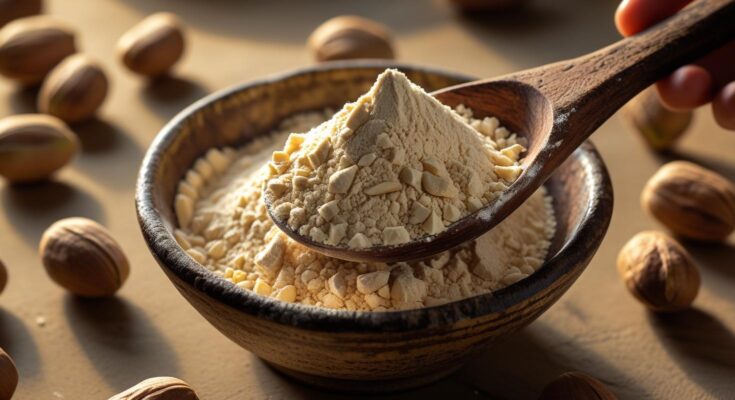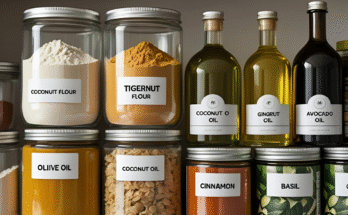Introduction
When starting the Autoimmune Protocol (AIP) diet, one of the first hurdles many face is figuring out what flours are safe to use. Since grains, legumes, nuts, and seeds are eliminated during the elimination phase, traditional flours like wheat, almond, or even oat are off-limits.
The good news? There are several AIP-approved flours that not only work well in recipes but also provide essential nutrients and textures that make AIP cooking enjoyable and sustainable.
In this guide, we’ll walk you through the best flours for the AIP diet, how to use each one, and when to choose one over the other based on the recipe. Whether you’re baking, frying, or thickening sauces, this article is your go-to reference.
What Makes a Flour AIP-Approved?
To be AIP-compliant, a flour must be:
- Grain-free
- Nut-free
- Seed-free
- Legume-free
That rules out many popular gluten-free alternatives like almond, flaxseed, or rice flour. Instead, we rely on root vegetables and fruits for safe, gut-friendly options.
Top AIP-Approved Flours (And How to Use Them)
1. Tigernut Flour
- What it is: Made from ground tigernuts — a root vegetable, not a nut.
- Texture & Flavor: Slightly sweet, nutty flavor; grainy texture.
- Best for: Cookies, energy bites, pie crusts.
- Tips: Works best when combined with another flour like arrowroot for structure.
💡 “Check out our Pantry and Substitutes Guide to learn how to stock up on AIP-friendly ingredients like tigernut flour.”
2. Cassava Flour
- What it is: Made from the whole cassava root.
- Texture & Flavor: Light, neutral taste; similar to wheat in texture.
- Best for: Tortillas, pancakes, baked goods.
- Tips: Absorbs more liquid than wheat flour — start with less and increase as needed.
3. Arrowroot Starch (or Flour)
- What it is: A starch extracted from the arrowroot plant.
- Texture & Flavor: Light, fine powder; virtually tasteless.
- Best for: Thickening sauces, binding ingredients, light baking.
- Tips: Combine with tigernut or cassava for structure and elasticity.
4. Tapioca Starch
- What it is: Made from the starch of the cassava root (not the whole root like cassava flour).
- Texture & Flavor: Chewy and stretchy; no strong flavor.
- Best for: Flatbreads, pizza crusts, chewy baked goods.
- Tips: Too much can make recipes gummy — balance with other flours.
5. Green Banana Flour
- What it is: Made from unripe, dried green bananas.
- Texture & Flavor: Mild banana flavor when raw, neutral when cooked.
- Best for: Muffins, cakes, pancakes.
- Tips: Rich in resistant starch — great for gut health!
Comparison Table
| Flour | Best Use Cases | Texture | Combine With |
| Tigernut | Cookies, pie crusts | Sweet, coarse | Arrowroot, tapioca |
| Cassava | Tortillas, muffins | Neutral, wheat-like | Arrowroot, banana |
| Arrowroot | Sauces, light baking | Light, starchy | Tigernut, cassava |
| Tapioca | Pizza crusts, chewy items | Stretchy, chewy | Cassava, banana |
| Green Banana | Cakes, pancakes | Dense, mild | Arrowroot, tigernut |
Which AIP Flour to Use Based on Recipe Type
🥞 For Pancakes and Waffles:
- Use: Cassava + banana flour
- Why: Cassava gives structure; banana adds lightness and holds moisture
🍪 For Cookies:
- Use: Tigernut + arrowroot
- Why: Tigernut adds a sweet, grainy texture; arrowroot binds
🍰 For Cakes and Muffins:
- Use: Green banana + tapioca
- Why: Banana adds softness; tapioca helps rise and hold shape
🍲 For Sauces and Gravies:
- Use: Arrowroot
- Why: Arrowroot thickens smoothly without altering flavor
AIP Flours to Avoid
Even though they’re popular in gluten-free recipes, these are not AIP-compliant:
🚫 Almond flour
🚫 Coconut flour (eliminated during the strict phase)
🚫 Flaxseed, chia seed flour
🚫 Cornstarch
🚫 Rice flour
Where to Buy AIP-Approved Flours
You can find most of these in:
- Health food stores
- Online shops like Amazon, Thrive Market, and AIP-specific retailers
- Local markets with natural or international foods
Tips for Using AIP Flours Successfully
- Always measure by weight if possible — AIP flours vary in density
- Test in small batches until you get the hang of texture and moisture levels
- Mix and match — single AIP flours rarely work perfectly alone
- Store in airtight containers to keep them fresh and prevent clumping
FAQs About AIP-Approved Flours
Q: Can I use coconut flour on AIP?
A: Coconut products are reintroduced for many people after the elimination phase, but during strict AIP, it’s best to avoid coconut flour due to its concentration.
Q: Are AIP flours expensive?
A: They can be, but buying in bulk or online through discount sellers helps. Making your own (like green banana flour) can also save money.
Q: Which AIP flour is best for baking bread?
A: A blend of cassava, tapioca, and arrowroot often works well. AIP baking can be trial-and-error, so follow tested recipes when possible.
Final Thoughts
Navigating the world of flours on the AIP diet can feel overwhelming, but once you understand which ones to use and when, it becomes second nature. With AIP-approved options like tigernut, cassava, and green banana flour, you’ll be able to recreate many of your favorite dishes — from cookies to pancakes — while still staying true to your healing journey.
➡️ Don’t forget to check out our AIP Pantry and Substitutes Pillar Guide for a complete breakdown of all compliant ingredients!




